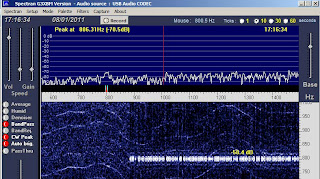 |
| ATU for 136kHz. Antenna connected to top of ferrite rod |
My conclusions are that an ultra-simple QRP approach to 136kHz TX is just not possible if one is to achieve useful results consistently.
Simple QRP projects, 10m, 8m, 6m, 4m, FT8, 160m, WSPR, LF/MF, sub-9kHz, nanowaves and other random stuff, some not related to amateur radio.
 |
| ATU for 136kHz. Antenna connected to top of ferrite rod |
 |
| DK7FC/P very strong on 136.8kHz CW today |
"I made an estimate of the field strength of your signal by injecting a test signal at a known EMF into the loop antenna, and comparing with the level of your signal. The received FS at the strongest point (around 1330utc) worked out to be 1.8uV/m. Taking the distance between our locations as 37km, your ERP would have been 87uW. The SNR at best was around 15dB, making the noise level 0.32uV/m in the FFT noise bandwidth of 2.1mHz, or a noise density of 7uV/m per sqrt(Hz)
Assuming a 50m vertical wire (heff ~ 25m), Rrad of your antenna at 8.97kHz would be 880micro-ohms. Assuming 2.62dB directivity for an electrically short monopole compared to a dipole, and Iant of 200mA, the calculated value of ERP would then be 64uW. So there is reasonable agreement between these two calculations, the difference only being 1.3dB."

My thanks to Steve G1KQH for bringing this to my notice. QRP Labs have the QMX+ multi-mode 160-6m transceiver on sale. Hans makes some rea...
